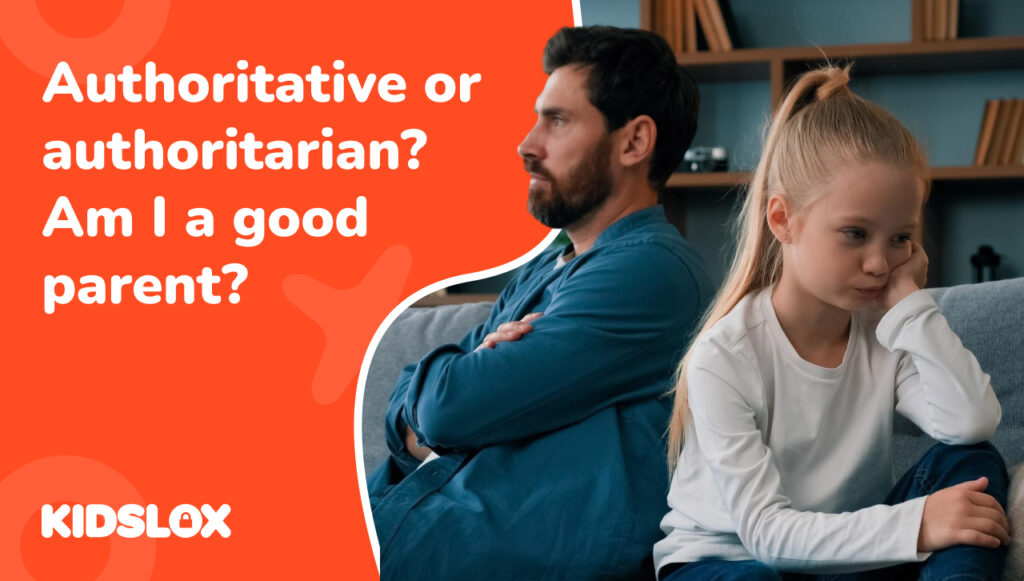What’s the Difference—and Why Does It Matter?
Parenting styles shape everything from a child’s behavior and confidence to their emotional wellbeing. Among the most commonly discussed approaches are authoritative parenting and authoritarian parenting. They might sound similar, but when it comes to how they play out in real life, they couldn’t be more different.
Understanding the distinction between the two is more than just semantics. It can influence how your child grows, learns, and forms relationships. Throughout this Guide To we’ll explore how each style works, what it looks like day to day, and why choosing the right approach makes a difference.
What Is Authoritative Parenting?
The authoritative parenting style is often seen as the gold standard. First defined by psychologist Diana Baumrind in the 1960s, it blends high expectations with emotional support, structure with flexibility.
Authoritative parents:
- Set clear expectations and consistent rules
- Encourage independence while providing guidance
- Use positive discipline based on reasoning and natural consequences
- Are emotionally responsive and supportive
- Promote open communication and mutual respect
This approach gives children a sense of stability while allowing them to grow into confident, independent thinkers.
What Is Authoritarian Parenting?
Authoritarian parenting, though often confused with authoritative, is fundamentally different. It emphasizes obedience, control, and discipline—with little room for discussion.
Authoritarian parents:
- Demand obedience without question
- Enforce rules without explanation
- Rely on punishment rather than guidance
- Offer minimal emotional support
- Restrict independence and personal choice
In psychological terms, authoritarian parenting is defined by high demands and low responsiveness. It falls under Baumrind’s four parenting styles, alongside authoritative, permissive, and uninvolved. In an authoritarian family, the household is often structured around rules, order, and respect—but emotional connection takes a back seat.
Authoritative Parenting Examples: What It Looks Like Day to Day
Homework time: An authoritative parent sets a routine but allows their child to choose the order of tasks. If homework is missed or rushed, the parent doesn’t jump to punish. Instead, they sit down with the child, talk through what went wrong, and help them come up with a plan for next time. The goal isn’t just getting the work done—it’s learning how to manage time and responsibility.
Screen time: Limits are explained clearly and applied consistently. For example, there might be a rule of “no screens after dinner” to protect sleep and focus on family time. If the child pushes that boundary, the parent calmly reminds them of the rule and enforces a reasonable consequence, like losing 15 minutes of screen time the next day. The child knows what to expect and why the rule exists.
Conflict: When a child is upset—maybe they’ve had an argument with a sibling or feel frustrated with school—the authoritative parent creates space to talk. They listen without interrupting, validate the child’s emotions, and help them name what they’re feeling. Then, they guide the child in finding a healthy solution. Rather than reacting emotionally themselves, they model emotional regulation.
Chores: Instead of demanding that chores be done “now or else,” an authoritative parent gives clear expectations and involves the child in the process. “You’re responsible for tidying your room by Saturday afternoon. Would you like to do it in one go or split it over two days?” This gives the child ownership while reinforcing responsibility.
Discipline: When rules are broken—whether it’s lying, misbehaving at school, or being unkind—the authoritative parent addresses the issue firmly but fairly. They explain why the behavior is a problem and offer a logical consequence. Importantly, they separate the behavior from the child’s identity, helping them feel safe even while being held accountable.
Authoritarian Parenting Style Examples: A Sharp Contrast
Homework time: The parent insists the child sits down immediately and completes all their assignments without delay. No input or discussion is allowed. If the child forgets something or struggles, they’re scolded or punished, often without any opportunity to explain or reflect. The focus is entirely on performance, not progress.
Screen time: Rules are handed down with no explanation. A child might be told, “No more TV—because I said so.” If the rule is broken, devices may be confiscated indefinitely. Discipline is often reactive and emotionally charged, involving yelling, shame, or blanket bans that may not be proportionate to the issue.
Conflict: When a child shows frustration—perhaps slamming a door or complaining—the parent sees it as a sign of disrespect. Instead of asking what’s wrong, they shut it down with phrases like, “Don’t talk back,” or “Go to your room until you can behave.” The child learns that expressing emotion is dangerous or unwanted.
Chores: Chores are commanded with no room for discussion. “Do the dishes now, or you’re grounded.” The child is not given warning or choice, and failure to comply often leads to punishment. There’s little recognition of effort or conversation about how to manage responsibilities fairly.
Discipline: If a rule is broken, authoritarian parents often reach for harsh punishments—grounding for a week, public shaming, or complete removal of privileges. The response is absolute and often delivered without explaining the “why.” Apologies and accountability are one-sided: the child is expected to “fall in line,” not learn or grow.
Comparing and Contrasting Authoritative and Authoritarian Parenting
So how do these styles truly differ?
Authoritative parents provide structure and guidance, but with warmth. They expect a lot, but also support a lot. They value independence and treat children with respect, using discipline as a teaching tool.
Authoritarian parents, in contrast, expect obedience without explanation. Their approach is stricter, less flexible, and more emotionally distant. Discipline is about compliance, not learning.
In short: authoritative parenting builds trust, confidence, and emotional intelligence. Authoritarian parenting might lead to short-term obedience—but often at the cost of connection, autonomy, and wellbeing.
How Might Children of Authoritative Parents Grow Up?
Children raised by authoritative parents are more likely to:
- Have high self-esteem
- Perform well in school
- Develop strong social skills
- Make responsible decisions
- Feel secure in relationships
This parenting style creates a healthy foundation for both emotional and practical life skills.
And the Effects of Authoritarian Parenting?
Children from authoritarian homes might follow rules early on, but over time they can experience:
- Low self-esteem
- Poor decision-making skills
- Increased anxiety or depression
- Weaker social skills
- Rebellious or secretive behavior
By focusing on obedience over understanding, authoritarian parenting can undermine a child’s emotional development.
The Deeper Consequences of Authoritarian Parenting
- Emotional Suppression
Children may learn to bottle up their feelings, which can lead to emotional detachment or difficulty expressing themselves later. - Lack of Critical Thinking
Obedience without explanation discourages kids from thinking independently or questioning harmful behaviors—in peers, partners, or future authority figures. - Fear-Based Relationships
Children raised with authoritarian parenting often see relationships as power struggles. They may grow up fearing conflict or avoiding emotional intimacy.
Authoritarian Parenting: Pros and Cons
Every style has pros and cons. Here’s a quick summary of authoritarian parenting:
Pros:
- Children may follow rules reliably
- Offers structure and order
- Can reduce risk-taking in early years
Cons:
- Can damage emotional wellbeing
- Discourages independence
- May lead to low confidence and resentment
- Often results in poor long-term communication
While it can create short-term compliance, the long-term authoritarian parenting effects are generally more harmful than helpful.
Why Do Some Parents Choose Authoritarian Parenting?
There are many reasons why parents lean toward an authoritarian approach:
- Cultural or generational expectations
- Their own upbringing (“I turned out fine”)
- Fear of losing control or being too permissive
- Misunderstanding the difference between structure and harshness
Often, these parents are doing their best with the tools they have. They want what’s best for their kids—but may not have had other examples to follow.
Authoritative Parenting in Different Ages and Stages
The way authoritative parenting is applied changes as children grow. In early childhood, it might involve giving toddlers a choice between two outfits or gently reinforcing routines. As kids enter the primary school years, authoritative parents often collaborate more with their children—offering increasing autonomy with clear expectations. By adolescence, it’s less about managing behavior and more about guiding decisions and supporting independence. Throughout each stage, the focus stays on connection, respect, and reasonable boundaries.
How to Tell Which Parenting Style You’re Using
If you’re unsure which category you fall into, consider the following questions:
- Do I explain the reasons behind my rules?
- Does my child feel safe expressing their thoughts or emotions with me?
- Do I discipline with the goal of teaching, or simply to control?
- Am I consistent without being overly rigid?
These small reflections can reveal whether your style leans more toward connection or control.
Balanced Discipline Strategies
Discipline doesn’t have to mean punishment. Authoritative parents focus on teaching rather than controlling. For example:
- If a child breaks a rule, the consequence is logical (e.g., no TV the next day if they break screen-time rules).
- If they speak rudely, they’re asked to reflect and apologise—not just punished with a time-out.
- Boundaries are clear, but always explained in age-appropriate ways.
The goal is not perfection, but growth. Mistakes are treated as learning moments, not character flaws.
Authoritative Parenting and Screen Time
One of the biggest modern parenting challenges is managing screens. Authoritative parents don’t just restrict screen time—they guide it.
That means explaining why limits exist, involving kids in setting boundaries, and using tools like Kidslox to make expectations consistent and easy to follow. Rather than yelling about YouTube or confiscating a tablet in frustration, they use screen-time conversations as opportunities to teach balance, responsibility, and trust.
Is It Too Late to Make a Change?
Not at all. If you see authoritarian patterns in your parenting and want to shift toward a more authoritative style, it’s never too late.
Here’s how to start:
- Reflect on your own experience
Ask yourself: why do I react this way? What did I learn about parenting growing up? - Start communicating
Explain rules and decisions. Let your child express their side, even when you don’t agree. - Validate emotions
Let your child know their feelings are real and important—even when their behavior needs correcting. - Stay consistent, not rigid
Keep boundaries clear but flexible. Use discipline to teach, not punish. - Build trust
Children are more likely to cooperate when they feel respected, heard, and understood.
Choosing Connection Over Control
Knowing the difference between authoritative vs authoritarian parenting helps you make better decisions, build stronger relationships, and support your child’s growth.
The authoritative parenting style blends high expectations with emotional warmth. It creates a safe space for kids to thrive, not just behave. The authoritarian style, while often well-meaning, can do more harm than good.
Kids don’t just need discipline—they need connection, trust, and room to grow.





